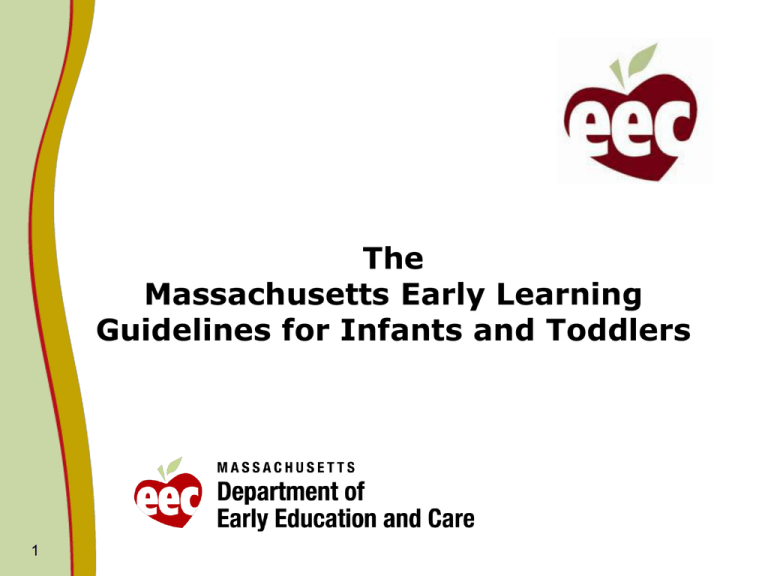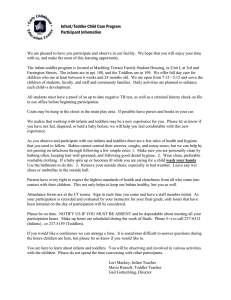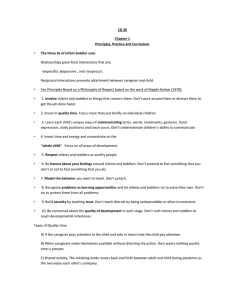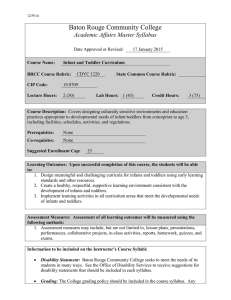The Massachusetts Early Learning Guidelines for Infants and Toddlers 1
advertisement

The Massachusetts Early Learning Guidelines for Infants and Toddlers 1 The Early Learning Guidelines for Infants and Toddlers: Timeline 2 March 22, 2010: Grant awarded to MassAEYC March 22nd to June 30th: MassAEYC gathered current knowledge, research, and best practice to develop draft July 1st: Initial draft submitted to EEC for review EEC gave comment and MassAEYC revised the Guidelines August 16th to September 2nd: MassAEYC holds focus group comment sessions jointly with EEC across state August 24th: Revised draft Guidelines and survey posted on EEC website September 25th: comment period ends September 25th to October 31st : MassAEYC revises Guidelines and finalizes them with EEC staff October 31st : Final Draft submitted to EEC and Board Board votes on Guidelines at November Board meeting November 1st to December 31st: Implementation phase January 1st: Guidelines in effect The Massachusetts Early Learning Guidelines for Infants and Toddlers: Overview of Guidelines 3 The Early Learning Guidelines for Infants and Toddlers : Purpose 4 Provide a comprehensive view of the development of infants and toddlers while documenting experiences that support their development (birth to 33 months) To use as a resource for infant and toddler programs, educators, families, higher education, and communities The Early Learning Guidelines for Infants and Toddlers : Focus 5 New brain development research Strength based approach values Family partnerships are Key Communicate interrelated nature of domains Describe how programs and educators can best support and interact with infants and toddlers Create a learning continuum Relationships are key factor in development and learning The Early Learning Guidelines for Infants and Toddlers : Principles 6 Family as defined by culture is child’s primary support Learning is embedded in child’s culture Child develops at own rate Child has own personal learning approach Nurturing occurs through respectful & responsive relationships Learning is interconnected in each domain Learning occurs by informed, reflective, curious adults Play is the foundation for learning Rich, responsive language experiences, in families’ language prime child for academic success The Early Learning Guidelines for Infants and Toddlers : Format 7 Table of Contents Introduction to Guidelines Younger/Older Infants (0-8 mos., 6-15 mos.) Younger /Toddlers (12-4 mos., 22-33 mos.) Beyond the Basics: Best Practices Appendix Each section arranged by developmental domains: Physical and Well Being Social and Emotional Cognitive Language and Communication Approaches to Learning NOTE: Footnotes, references, bibliography to be added The Massachusetts Early Learning Guidelines for Infants and Toddlers: Research, Development and Review 8 The Early Learning Guidelines for Infants and Toddlers: Research & Development Phase 9 Knowledge, research and Best Practice: Review of Guidelines from 22 States Meetings with Infant and Toddler Experts Consultation from National Center for Infants Toddlers and Families (Zero to Three) Meetings between developers and EEC The Early Learning Guidelines for Infants and Toddlers: Review and Comment Phase 10 Internal EEC staff including licensing staff gave comment Focus groups across the state were jointly facilitated by MassAEYC and EEC Guidelines are posted online with a survey from August 22nd to September 21st in total, over 350 people have reviewed and commented on the Guidelines The Early Learning Guidelines for Infants and Toddlers: Focus Groups 11 7 Focus groups across the state were jointly facilitated by MassAEYC and EEC including: MassAEYC family child care conference A focus group in Springfield for Spanish speaking family child care educators Over 260 educators were reached: Family child care educators, Center based directors Infant and toddler educators Higher education, Head Start, Early Intervention other community organizations gave comment The Early Learning Guidelines for Infants and Toddlers: Focus Groups Constructive comments from the focus groups include: 12 Could have more about spending time in containers (consumerism isn’t helpful for parents in making decisions about good equipment purchases) Could have more about biting The document is written for educators Please have a way to search words in document on line Would like something about the universality of sign language Would like something about the universality of music. More about music More on feeding More about using the outside playground Add finding a safe place for tummy time Repeating supportive learning experiences limits the teaching. Please add new strategies Use healthy lifestyle instead of obesity Needs more on special needs. Look at CSFEL for more on inclusion The Early Learning Guidelines for Infants and Toddlers: Online Review 72 people have responded to on line survey. The survey will remain posted until September 17th Respondents come from a variety of settings: 13 The Early Learning Guidelines for Infants and Toddlers: Online Review Most respondents to survey tell us they work with toddlers and infants 14 The Early Learning Guidelines for Infants and Toddlers: Online Review 15 97% agree that directions for using the document are clear 97% agree that the supportive learning experiences can be used in their work with infants and toddlers 100% agree that information in the document is easy to find 94% agree that the document is culturally sensitive 97% agree that the document is responsive to children with differing abilities The Early Learning Guidelines for Infants and Toddlers: Online Review Constructive comments include: 16 Document is too long. People may skip over materials I would like more examples of activities to help parents or caregivers interact better with children More resources in the appendix Would like more specific supportive learning examples Language may be unfamiliar with some groups making the guidelines not very user friendly There should be some specific resources for various cultures Would like more specific information about children with identified special needs Maybe too much information condensed into this one document Would like more on natural environments in the classroom Would like something about including men as teachers, volunteers and fathers in best practice section Educational jargon may be difficult for parents and some community members The Massachusetts Early Learning Guidelines for Infants and Toddlers: Addressing Comments and Completing Revisions 17 The Early Learning Guidelines for Infants and Toddlers: Content Area Expansion MassAEYC will expand the content in the areas of: 18 Dual language learners Supporting family culture Inclusion and Special needs Home visiting Integration between domains Partnerships with families Consumerism Biting and Behavior Management Men as teachers The Early Learning Guidelines for Infants and Toddlers: Document Format 19 MassAEYC will: Complete basic editing Secure a professional editor to complete the final review Complete the appendix to include references and resources EEC will: Resolve format issues Assure there is a word search mechanism for the final online document The Early Learning Guidelines for Infants and Toddlers: Comment Period Your comments are appreciated Please forward comments to: janet.mckeon@massmail.state.ma.us 20




